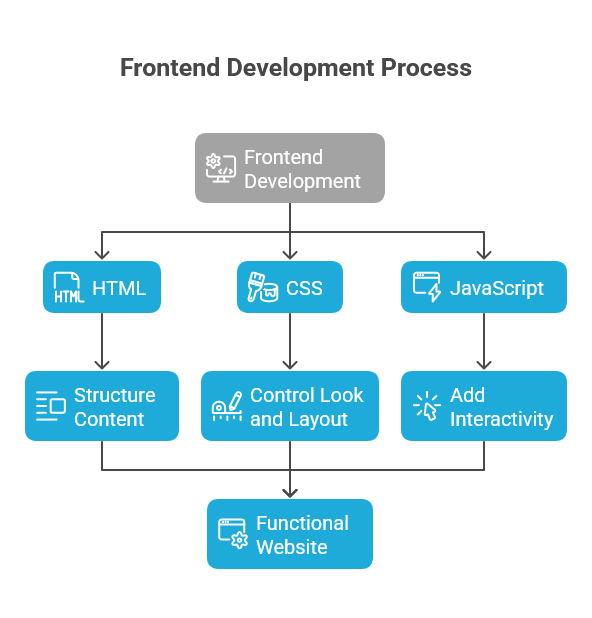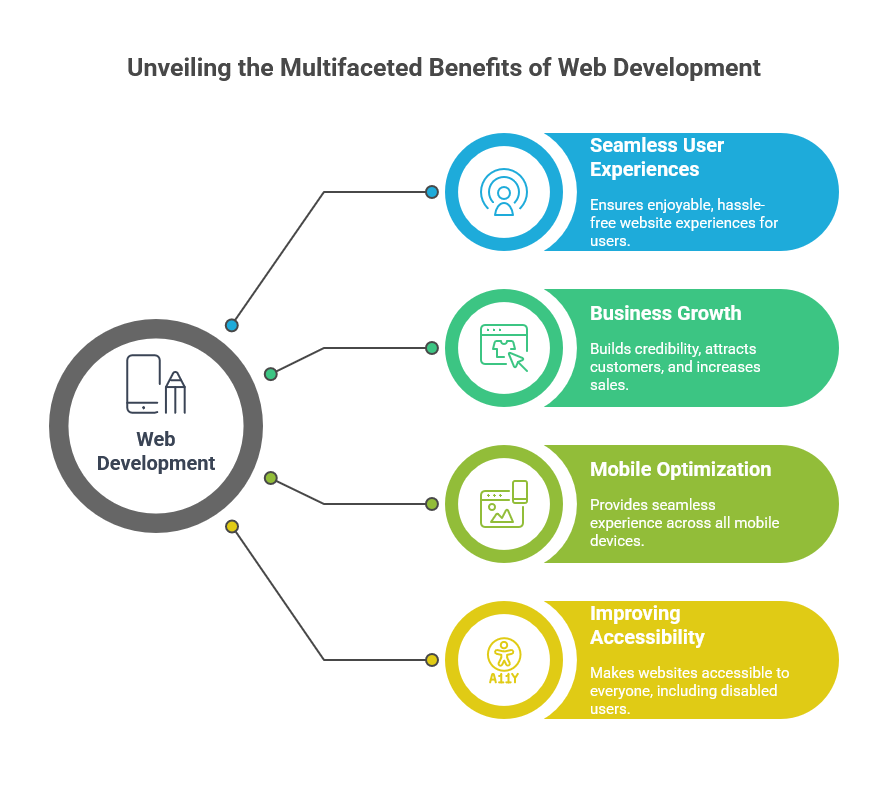Web development powers every online experience, whether you visit a simple blog or interact with a complex web application. As the digital world grows, web development becomes more crucial than ever. Whether starting your career in web development or refining your skills, understanding web development is key to succeeding in the digital world.
The web development industry continues to grow rapidly. Statista reports that the global web development market reached $40.1 billion in 2020 and expects it to grow at a compound annual growth rate (CAGR) of 4.4% from 2021 to 2028 (Statista, 2021).
What Is Web Development?
Web development refers to the process of building websites and web applications. It includes everything from creating basic static pages to designing complex, data-driven websites or web apps. Web developers focus on structuring content, ensuring smooth user experiences, and implementing functionalities like contact forms, login systems, or data processing.
Web development is divided into three main areas: frontend, backend, and full-stack development. Each requires different tools and skills, but they contribute to the final product.
Key Components of Web Development
Web development involves several components, each essential in creating a functional and visually appealing website or web application.
Frontend Development
Frontend development focuses on everything users see and interact with in their web browsers. It involves designing the layout, adding colors and images, and ensuring the site functions well across different devices. Frontend developers make the site visually attractive and user-friendly.
Key technologies used in frontend development:
-
HTML (HyperText Markup Language): HTML structures the content on the webpage.
-
CSS (Cascading Style Sheets): CSS controls the look and layout of the webpage.
-
JavaScript: JavaScript adds interactivity, enabling dynamic content such as animations and interactive features.
Together, these technologies allow developers to create websites that are both functional and visually appealing.

Backend Development
Backend development involves all the processes that occur behind the scenes. Developers work with databases, servers, and application logic to ensure the website operates smoothly. They are responsible for handling data management, server communication, and ensuring that the website effectively delivers user content and functionality.
They handle user authentication, data storage, and communication between the server and the client-side (frontend).
Backend development uses technologies such as:
-
PHP: PHP is a popular scripting language used for creating dynamic websites.
-
Python: Python is known for its simplicity and powers many web applications.
-
Ruby on Rails: Ruby on Rails is a framework that helps developers build scalable web applications.
-
Node.js: Node.js allows developers to use JavaScript on the server-side, creating a unified development environment.
Full-Stack Development
Full-stack developers have expertise in both frontend and backend development. They can handle all aspects of web development, from creating the user interface to managing the backend infrastructure. Full-stack developers are versatile and crucial in smaller teams or startups.
The Web Development Process
Creating a website or web application involves several phases. Each phase ensures the website functions properly, looks good, and provides an excellent user experience.
1. Planning and Research
The planning phase is the first and most critical step in web development. Developers and designers define the website’s purpose and identify its target audience. They also decide on the features and functionalities needed, such as contact forms or shopping carts. This phase involves researching the audience’s needs and preferences, ensuring the website serves its intended purpose.
2. Design
In the design phase, developers and designers create the look and feel of the website. They focus on the user interface (UI) and user experience (UX), ensuring the site is visually appealing and easy to navigate. Designers create wireframes or mockups representing the website’s layout and design.
3. Development
After finalizing the design, the development phase begins. Developers use HTML, CSS, JavaScript, and backend technologies to bring the design to life. Frontend developers code the user interface, while backend developers work on the server-side functionality, databases, and application logic.
4. Testing
Testing is an essential part of the web development process. Developers test the website to ensure it functions as expected. They check for bugs, broken links, and performance issues. This phase also includes usability testing to ensure the website is user-friendly and accessible across different devices.
5. Launch
After passing the testing phase, the website is ready for launch. Developers upload the website to a hosting server and connect it to the domain name. They also ensure that everything works smoothly and monitor the website for any issues that may arise post-launch.
6. Maintenance
Even after the website goes live, it requires ongoing maintenance. Regular updates, bug fixes, and performance improvements ensure that the website remains functional and relevant over time. Developers also implement security updates to protect the site from potential threats.
The Importance of Web Development
Web development is vital for anyone looking to establish a successful online presence. It provides several benefits, including the following:
1. Creating Seamless User Experiences
Good web development ensures users have an enjoyable and hassle-free experience when visiting a website. A well-developed site loads quickly, functions properly, and provides clear, easy-to-find content. Web development plays a crucial role in user engagement and satisfaction by making sites easy to use.
2. Supporting Business Growth
A website serves as a business’s digital face. A well-developed site can help businesses build credibility, attract customers, and increase sales. Web development is essential for improving businesses’ online presence and reaching a larger audience. A strong website can increase visibility and ultimately drive business growth.
3. Mobile Optimization
More people access websites through mobile devices than ever before. Web development ensures that websites are mobile-responsive, meaning they work well on smartphones, tablets, and desktops. Mobile optimization is crucial for reaching a wider audience and providing a seamless experience to users across all devices.
4. Improving Accessibility
Web development makes websites accessible to everyone, including people with disabilities. Accessible websites provide equal access to information and services, ensuring that users with visual or hearing impairments can navigate the site. Web developers implement accessibility features like screen reader compatibility, keyboard navigation, and text resizing to make websites more inclusive.

The Future of Web Development
Web development continues to evolve as technology advances. Here are some trends to watch for in the future:
1. Artificial Intelligence (AI) in Web Development
AI is starting to make its way into web development, bringing more advanced features to websites. AI will enable websites to personalize content based on user behavior, automate tasks like customer support with chatbots, and improve user interactions. Developers will likely incorporate AI-powered tools into websites, enhancing the overall experience.
2. Progressive Web Apps (PWAs)
PWAs offer a hybrid experience, combining the best aspects of websites and mobile apps. PWAs load quickly, work offline, and allow users to add the site to their home screens. As mobile traffic continues to increase, PWAs will become a go-to solution for providing faster, app-like experiences to users.
3. Voice Search Optimization
As voice-activated devices like Amazon Echo and Google Home become more popular, voice search optimization will become increasingly important. Developers will need to optimize websites to understand voice queries and provide accurate responses to users. Voice search will also influence how businesses approach SEO and online marketing.
4. Single-Page Applications (SPAs)
Single-page applications (SPAs) provide a fast, seamless user experience by loading content dynamically on a single page. This means users don’t have to wait for entire pages to reload when navigating a website. SPAs offer a more interactive and engaging experience, and developers will continue to rely on them for dynamic, modern web applications.
Frequently Asked Questions (FAQ)
1. What skills do I need to become a web developer?
To become a web developer, you must learn HTML, CSS, JavaScript, and backend programming languages like PHP, Python, or Ruby.
2. What is the difference between frontend and backend development?
Frontend development creates the website’s visual elements, while backend development handles the server-side logic and database management.
3. How long does it take to become a web developer?
Becoming proficient in web development can take six months to a year, depending on your learning time.
4. Can I learn web development on my own?
Many online resources and tutorials help you learn web development independently.
5. Why is web development important for businesses?
Web development ensures businesses have a strong online presence, attract customers, and provide a positive user experience that drives sales and engagement.
Web development is crucial in building and maintaining the digital experiences that users expect today. From simple websites to complex web applications, web development enables businesses, creators, and organizations to connect with their audience effectively. As technology evolves, so does web development, and keeping up with the latest trends ensures success in this ever-changing field.
👍 Get Stunning Lifetime Access Now!

